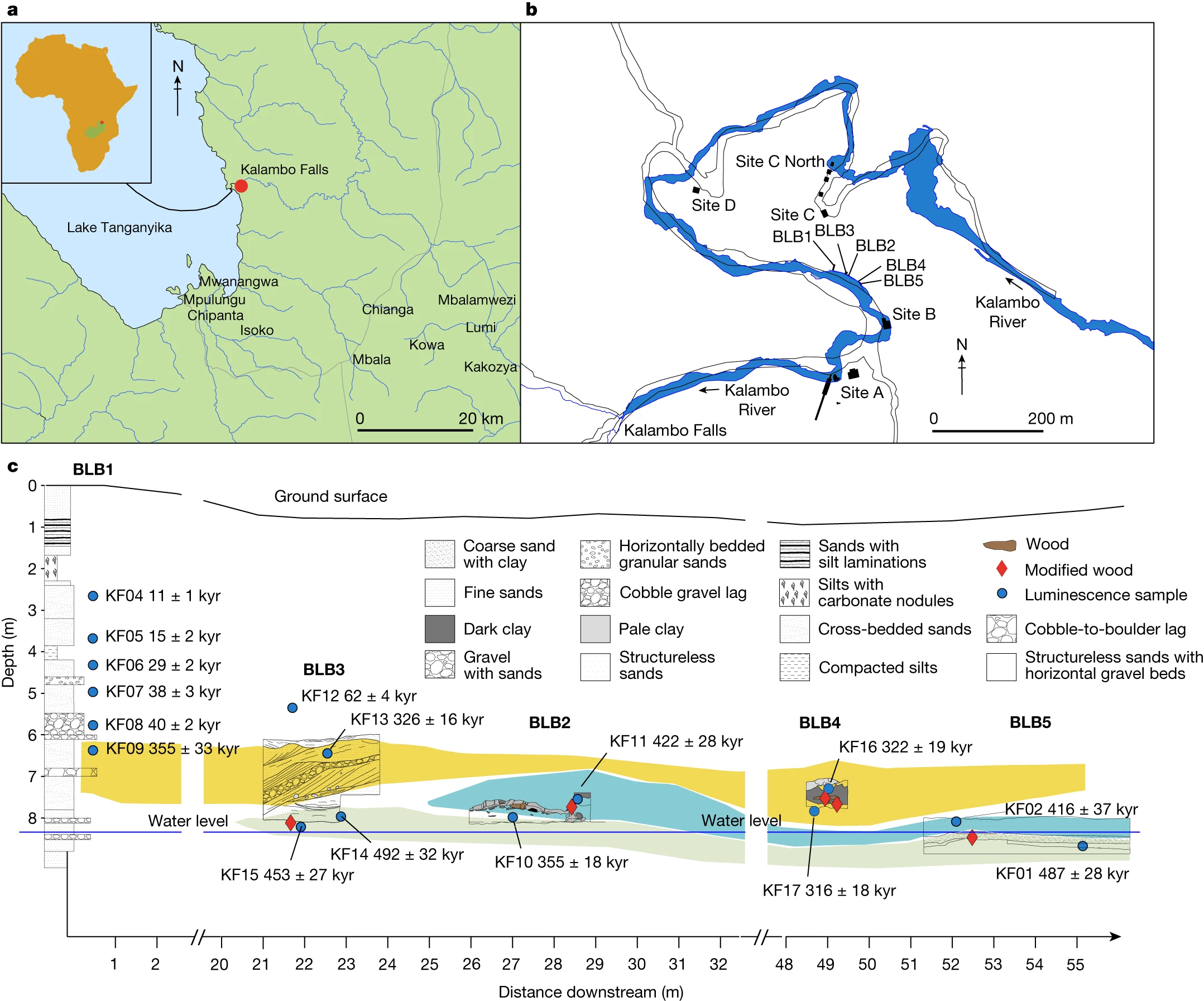Skip to comments.
Earliest evidence of buildings made from wood is 476,000 years old
New Scientist ^
| 20 September 2023
| Colin Barras
Posted on 07/10/2025 8:42:22 AM PDT by SunkenCiv
Ancient humans were building large wooden structures -- possibly houses -- almost half a million years ago. The discovery, the earliest evidence of wooden construction, suggests that some ancient communities were far less nomadic than we have assumed...
One of the first artefacts they found was a wooden tool, probably a digging stick. "The number of sites where wood is preserved is small," says researcher Geoff Duller at Aberystwyth University, UK...
...a 1.4-metre-long log overlying an even larger log that was too big to fully excavate during their month-long project. They saw that the overlying log had been worked with tools to fashion a deep notch midway along its length. This allowed it to interlock with the underlying log at a 75-degree angle, creating a relatively sturdy joint. The researchers speculate that the two interlocking logs were once part of a larger wooden structure...
Duller then dated the artefacts using a technique called post-infrared infrared stimulated luminescence. This involves measuring the time since the mineral grains in the sand that surrounded the wood were last exposed to light prior to their burial. The mineral grains -- and the artefacts they surround -- were buried about 476,000 years ago... The engineers therefore belonged to an earlier human species, possibly Homo heidelbergensis...
...researchers have discovered 300,000-year-old wooden spears at a site in Germany, possibly made by H. ...
The engineers at Kalambo Falls needed to produce sharp-edged stone tools from rocks, recognise they could use those tools to cut through wood and then work in groups to transport and modify that wood to produce a large structure...
...says Barham... "We might need to rethink our labelling of the Stone Age," he says. "Maybe it was more of a wood age."
(Excerpt) Read more at newscientist.com ...
TOPICS: History; Science; Travel
KEYWORDS: africa; fauxiantroll; fauxiantrolls; godsgravesglyphs; paleolithic; youngearthdelusion; youngearthdelusions; zambia
Navigation: use the links below to view more comments.
first 1-20, 21-31 next last
a, Site location in south-central Africa. b, Course of the Kalambo River (in outline) from around 1956 to 2006 in relation to previous excavations at sites A, B, C, D and C North. Site BLB (2019) and excavation units BLB1, BLB2, BLB3, BLB4 and BLB5 are located along the current main channel (blue). c, Cross-section of the 2019 excavation units showing the location of 16 luminescence dating samples (KF01 -- KF17, dark blue circles, uncertainties (±) shown at 1 − σ) by unit. Unit BLB1 is a geological section of the full cliff exposure from ground surface to below water level. The three colour bands indicate clusters of pIR IRSL ages grouped by mean ages and standard error of the mean. The earliest wood objects (BLB5, BLB3) are in the lower green band with a mean age of 476 ± 23 kyr. The blue band has a mean age of 390 ± 25 kyr and incorporates the wood object in BLB2. The overlying yellow band has a mean age of 324 ± 15 kyr and incorporates wood objects in BLB4. Red diamonds indicate modified wood objects. Inset map data in a: Google Maps, Google 2021, INEGI; the map of Kalambo Falls was drawn using Arc-GIS Open Street Map. Map data in b: Google Imagery 2021 CNES/Airbus, Maxar Technologies; the 1960s river course, with site locations, was redrawn from figure 7.2 of ref. 17 with permission from Cambridge Univ. Press.Cambridge Univ. Press

[Evidence for the earliest structural use of wood at least 476,000 years ago | Nature | L. Barham, G. A. T. Duller, I. Candy, C. Scott, C. R. Cartwright, J. R. Peterson, C. Kabukcu, M. S. Chapot, F. Melia, V. Rots, N. George, N. Taipale, P. Gethin & P. Nkombwe | Published: 20 September 2023]
1
posted on
07/10/2025 8:42:22 AM PDT
by
SunkenCiv
To: StayAt HomeMother; Ernest_at_the_Beach; 1ofmanyfree; 21twelve; 24Karet; 2ndDivisionVet; 31R1O; ...
2
posted on
07/10/2025 8:43:39 AM PDT
by
SunkenCiv
(The moron troll Ted Holden believes that humans originated on Ganymede.)
To: SunkenCiv
Been saying this for years. Antediluvian civilizations probably had some magnificent buildings which have long-ago succumbed to the genuine ravishes of time.
3
posted on
07/10/2025 8:46:21 AM PDT
by
BenLurkin
(The above is not a statement of fact. It is opinion or satire. Or both.)
To: SunkenCiv
“post-infrared infrared stimulated luminescence”
mmm...what? C14 works only on post-flood specimens so they’ve cooked up something new.
To: SunkenCiv
Carbon 14 dating not cutting the desired amount of ice....
To: one guy in new jersey
To: SunkenCiv
7
posted on
07/10/2025 9:08:27 AM PDT
by
Cincinnatus.45-70
(What do DemocRats enjoy more than a truckload of dead babies? Unloading them with a pitchfork!)
To: SunkenCiv
8
posted on
07/10/2025 9:11:16 AM PDT
by
larrytown
(A Cadet will not lie, cheat, steal, or tolerate those who do. Then they graduate...)
To: SunkenCiv
How did they get all the way from Heidelberg to Tanganyika?
To: SunkenCiv
Saw it on Zillow, a bit of a fixer-upper.
10
posted on
07/10/2025 9:24:14 AM PDT
by
Made In The USA
(One and Two and Three and Four and)
To: SunkenCiv
The Homo heidelbergensis master race?!?
To: ScottHammett
It can actually date stone from the surrounding strata layers with very good accuracy. The old saying “you can’t date stone” is no longer true. Now they can, and it is pretty accurate. It can tell when the last time the stone was exposed to sunlight before it was buried. It is rewriting new dates to old finds. Some are younger than claimed, some are even older than they claimed. It goes both ways...
12
posted on
07/10/2025 9:41:39 AM PDT
by
Openurmind
(AI - An Illusion for Aptitude Intrusion to Alter Intellect. )
To: SunkenCiv
I for one am totally shocked that early humans would build with wood. /S
13
posted on
07/10/2025 9:47:35 AM PDT
by
Seruzawa
("The Political left is the Garden of Eden of incompetence" - Marx the Smarter (Groucho))
To: SunkenCiv
They were the hunters and farmers who supplied the city folk who lived by river mouths and along the coast.
14
posted on
07/10/2025 10:02:07 AM PDT
by
PIF
(They came for me and mine ... now its your turn)
To: SunkenCiv
Did they count all those tree rings?
15
posted on
07/10/2025 10:14:53 AM PDT
by
Scrambler Bob
(Running Rampant, and not endorsing nonsense; My pronoun is EXIT. And I am generally full of /S)
To: Made In The USA
16
posted on
07/10/2025 10:37:43 AM PDT
by
SunkenCiv
(The moron troll Ted Holden believes that humans originated on Ganymede.)
To: one guy in new jersey
Yes, troll, that’s why they didn’t use carbon 14 dating.
17
posted on
07/10/2025 10:38:42 AM PDT
by
SunkenCiv
(The moron troll Ted Holden believes that humans originated on Ganymede.)
To: SunkenCiv
Yeah big deal.
They didn’t pull proper permits for them so it doesn’t count
To: ScottHammett
C14 works back to about 45,000 years ago. There are various kinds of other radiometric dating, and none of it is “cooked up”.
19
posted on
07/10/2025 10:39:44 AM PDT
by
SunkenCiv
(The moron troll Ted Holden believes that humans originated on Ganymede.)
To: Cincinnatus.45-70
20
posted on
07/10/2025 10:40:20 AM PDT
by
SunkenCiv
(The moron troll Ted Holden believes that humans originated on Ganymede.)
Navigation: use the links below to view more comments.
first 1-20, 21-31 next last
Disclaimer:
Opinions posted on Free Republic are those of the individual
posters and do not necessarily represent the opinion of Free Republic or its
management. All materials posted herein are protected by copyright law and the
exemption for fair use of copyrighted works.
FreeRepublic.com is powered by software copyright 2000-2008 John Robinson


